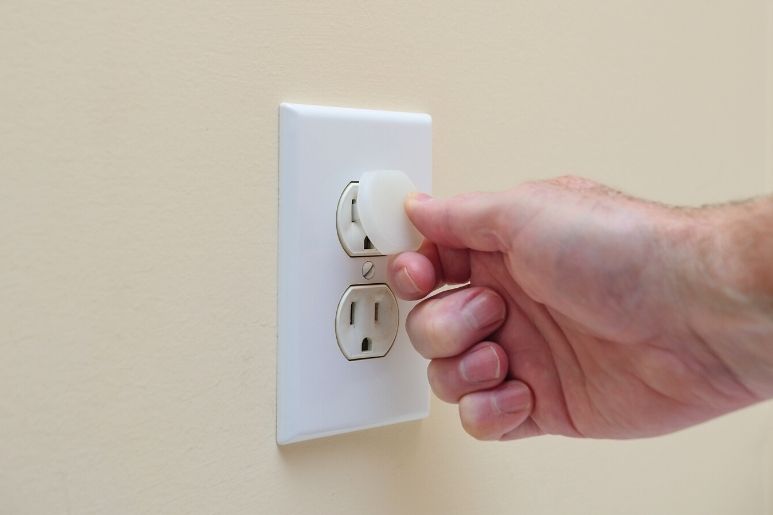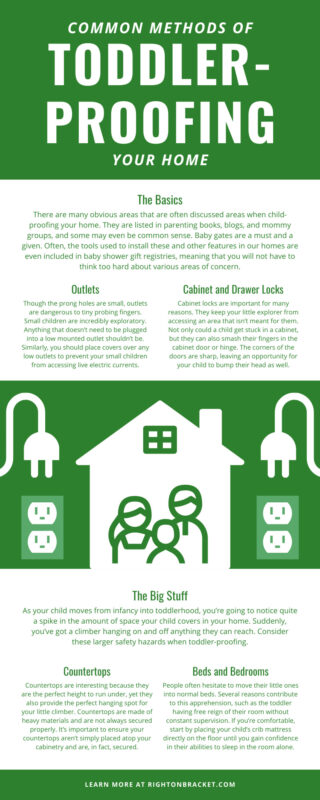
Common Methods of Toddler-Proofing Your Home
It can be hard to predict what your little ones will find to get into. No matter how many precautionary measures you take, it seems that your kids will always find the one thing you never considered. There are several ways to make sure your home is as safe as possible for your young family. Review common methods of toddler-proofing your home to ensure you’ve got your bases covered.
The Basics
There are many obvious areas that are often discussed areas when child-proofing your home. They are listed in parenting books, blogs, and mommy groups, and some may even be common sense. Baby gates are a must and a given. Often, the tools used to install these and other features in our homes are even included in baby shower gift registries, meaning that you will not have to think too hard about various areas of concern.
Outlets
Though the prong holes are small, outlets are dangerous to tiny probing fingers. Small children are incredibly exploratory. Anything that doesn’t need to be plugged into a low mounted outlet shouldn’t be. Similarly, you should place covers over any low outlets to prevent your small children from accessing live electric currents. Not only are outlets dangerous for fingers, but if your child finds something made of a conductive material and sticks it into the outlet, they are sure to receive a pretty significant shock.
Cabinet and Drawer Locks
Cabinet locks are important for many reasons. They keep your little explorer from accessing an area that isn’t meant for them. Not only could a child get stuck in a cabinet, but they can also smash their fingers in the cabinet door or hinge. The corners of the doors are sharp, leaving an opportunity for your child to bump their head as well. Finally, cabinets keep dangerous supplies for cleaning and storage out of the reach of children.
Chemical Safety
Cabinet locks are also important because they keep your child safe from dangerous chemicals, as we briefly mentioned above. It takes but a split second for your child to ingest hazardous products or spill them onto their skin or into their eyes. If you don’t see your child ingest such chemicals, you may not be able to determine what’s wrong when your child falls ill. Additionally, many household chemicals are so toxic that they cause severe damage to the brain and body. All lethal products should be locked away or stowed up high where they will be well out of reach of tiny hands.
Bathrooms
Bathrooms are full of chemicals that need to be secured. Apart from various cleaning agents are soaps, shampoos, hair removers, and more. The shower alone contains many potential dangers, such as falling into the tub, hitting the spout, accessing a sharp razor, or ingesting shower gels. The toilet can also pose a drowning hazard and should have a lock on it.
Additionally, it may be worth reversing the doorknob or removing the lock on the bathroom while your child is small. This is not a place that you want to be locked out of while your little one is inside. Some scenarios seem farfetched, but for every precautionary tool or rule, there was a tragic incident that someone experienced.
Laundering Area
The area in which you do laundry is dangerous for many of the same reasons as bathrooms. When you’re little, everything is so foreign and interesting. In addition to chemicals being accessible, your child could smash their fingers in the doors of washers and dryers or crawl into them.
Though it may seem doubtful that you would not notice a little one inside these appliances, it’s important to keep in mind that accidents are always possible. Keep doors secure at all times and try to disallow access to the laundry area.
Water Temperature
As you begin to teach your toddler autonomy, you can allow them the opportunity to use the restroom and sink with loose supervision. It is very important that you regulate the temperature of your water.
Scalding water can result in serious burns that lead to intense pain, blistering, bubbling, and scarring. Steam is also incredibly dangerous and can burn just as bad or worse than water. Protecting your little one from accessing any form of hot water is as easy as turning your water heater down. Moreover, as you teach basic self-care, teach your child to test the water with a pinky finger for extra safety. Often, what we think is hot or cold is very different than what a child interprets those temperatures to be.
The Big Stuff
As your child moves from infancy into toddlerhood, you’re going to notice quite a spike in the amount of space your child covers in your home. Suddenly, you’ve got a climber hanging on and off anything they can reach. Consider these larger safety hazards when toddler-proofing.
Countertops
Countertops are interesting because they are the perfect height to run under, yet they also provide the perfect hanging spot for your little climber. Countertops are made of heavy materials and are not always secured properly. It’s important to ensure your countertops aren’t simply placed atop your cabinetry and are, in fact, secured. More often than you think, the countertops just sit on the cabinets with the assumption that they can’t or won’t be moved.
Additionally, they should be secured for extra support with heavy-duty countertop brackets to ensure the countertops remain where they are placed. Turn to Right On Bracket for heavy-duty right angle support brackets that provide strong support and reliability without taking up too much space. Each set of brackets is American-made and hand-inspected to ensure you are getting a tested, quality product.
Beds and Bedrooms
People often hesitate to move their little ones into normal beds. Several reasons contribute to this apprehension, such as the toddler having free reign of their room without constant supervision. There’s also a potential to fall off a bed without sides. If you’re comfortable, start by placing your child’s crib mattress directly on the floor until you gain confidence in their abilities to sleep in the room alone. If the kiddo rolls off the mattress, it’s just a short trip to the floor.
Furthermore, it may be worth considering what’s necessary to have in your toddler’s room. If your child is going to be roaming around a lot, consider removing toys that could be hazardous. Your child probably has several locations for toys around the house; they don’t need even more toys in their bedroom while they learn to sleep out of the crib.
Securing Dressers and Shelving
Often, dressers are thought to be too large and too heavy for toddlers to move. Unfortunately, if a child climbs a dresser, it could become top-heavy and fall over onto the child. Therefore, securing dressers to the walls with furniture straps is imperative. This is not a scenario you want to wake up to.
Shelving throughout the home should be treated similarly. Avoid unnecessary shelving in the bedroom, as well as the other rooms in your home. In addition to countertop brackets, Right On Bracket offers floating shelf options with hidden brackets that will still allow you to display meaningful items in your home while keeping them out of reach of your toddler.
There are many common methods of toddler-proofing your home, all of which you should consider as you begin to build your family. The great news is that you have time. Babies are fairly immobile at first, which allows you at least six months before your little one will start to explore your home independently. Take it room by room and secure things as needed.



